

This Is The World As A Dolphin ‘Sees’ It. Dolphins in the waters off Mayotte. Dams drove an Asian dolphin extinct. They could do the same in the Amazon. The tucuxi (Sotalia fluviatilis), a river dolphin endemic to the Amazon, has been declared endangered on the IUCN Red List, meaning all the world’s freshwater dolphins are now at threat of extinction.The species faces the same threats as another Amazonian cetacean, the pink river dolphin (Inia geoffrensis), ranging from hydropower dams, to bycatch, to mercury poisoning.Researchers warn that if these threats intensify, the Amazon’s dolphins could go the way of the baiji (Lipotes vexillifer) in China, which is now considered extinct following a dam-building spree along the Yangtze.Researchers across South America are collaborating through the River Dolphins Dashboard to share 20 years of data and help inform conservation and development policies.
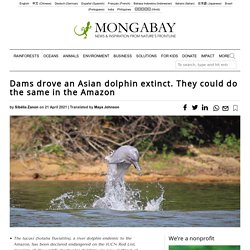
For decades it was the only freshwater dolphin species in the world not considered threatened by human activity. Dammed in Artisanal gold mining presents another danger, through the discharge of mercury into rivers. New tool for conservation. Orcas are first non-humans whose evolution is driven by culture. John Durban, NOAA Southwest Fisheries Science Center; research authorised by NMFS (US) By Colin Barras You could call it a culture shock.
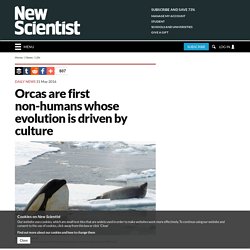
Many researchers accept that cultural experiences have helped shape human evolution – and evidence has now emerged that the same may be true of killer whales. Human genomes have evolved in response to our cultural behaviours: a classic example is the way that some human populations gained genes for lactose tolerance following the onset of dairy farming. But whether genomes and culture co-evolve in other animal species has been unclear. Andrew Foote at the University of Bern, Switzerland, and his colleagues suspected that killer whales might follow a similar pattern to humans. Advertisement. Leaping Dolphin. First new river dolphin species found since World War I. Dolphin jumps in front of boat. Ban On Tuna Labeled Dolphin-Safe Shows How TPP Will Crush Consumer Rights. (ANTIMEDIA) In the last 25 years, dolphin-safe labeling of tuna managed to reduce unnecessary annual deaths of the mammals from over 100,000 to only 3,000—an astounding 97% reduction—but the World Trade Organization just effectively nullified this critical program.
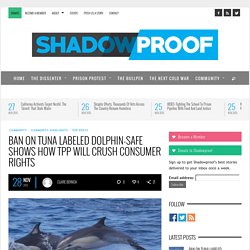
In order to placate Mexico as a member nation of the upcoming (and seemingly inevitable) Trans-Pacific Partnership (TPP), the WTO deemed dolphin-safe labeling a “technical barrier to trade”—even though that environmentally-conscious label is voluntary and applies equally to domestic and foreign companies. At issue are fishing methods that exploit the as-yet-unexplained symbiotic relationship between tunas and dolphins. As the Sierra Club explained: Tunas and dolphins are commonly found together in the Eastern Pacific Ocean. Taking advantage of this, many fishing companies purposefully ensnare dolphins in their nets so as to trap tuna, killing and injuring dolphins in the process. Freshwater Boto Dolphin of the Amazon. Maui's dolphin danger: 'We're running out of time' The last remaining 55 of world's rarest species of dolphins could disappear within three decades if New Zealand doesn't act now, wildlife advocates say.

The Last 55 campaign was launched by WWF-New Zealand at the Maritime Museum in Auckland today, calling on the Government to extend protection of marine reserves to cover the habitats of Maui's dolphins. The campaign launched a petition to attempt to collect 55,000 signatures before this year's general election. "Today, WWF is saying enough is enough.
We're running out of time," said WWF-NZ executive director Chris Howe. "It is election year, and we believe all politicians must act. " Maui's dolphins are an inshore coastal species with limited home range, slow to breed, and only found in the West Coast of the North Island. Happy Dolphins. Dolphin vs Porpoise - Difference and Comparison. Dolphins and porpoises are both cataceans, i.e. marine mammals, and are closely related to whales.
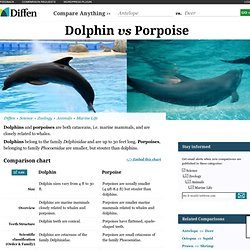
Dolphins belong to the family Delphinidae and are up to 30 feet long. Porpoises, belonging to family Phocoenidae are smaller, but stouter than dolphins. edit Anatomy Dolphins have a bulbous "melon" in the head distinct beak with conical teeth. Their dorsal fin is curved. Close up of a dolphin's head Porpoises have small, rounded heads and blunt jaws with flat, spade-shaped teeth. Edit Social Behavior Dolphins are social, living in pods of up to a dozen individuals. Porpoises are smaller and have a triangular dorsal fin Porpoises are relatively shy and are seen alone or in groups containing a few individuals, but rarely in large pods. Edit Intelligence. Orca hunting penguin. Why Does a Killer Whales Dorsal Fin Collapse? Question: Killer Whale (Orca) Dorsal Fin Collapse Have you ever wondered why killer whales in captivity have a dorsal fin that is flopped over, or 'collapsed?
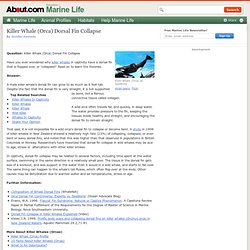
' Read on to learn the theories. Answer: A male killer whale's dorsal fin can grow to as much as 6 feet tall. Despite the fact that the dorsal fin is very straight, it is not supported by bone, but a fibrous connective tissue called collagen. A wild orca often travels far, and quickly, in deep water. That said, it is not impossible for a wild orca's dorsal fin to collapse or become bent. Another Monday morning on Utila.